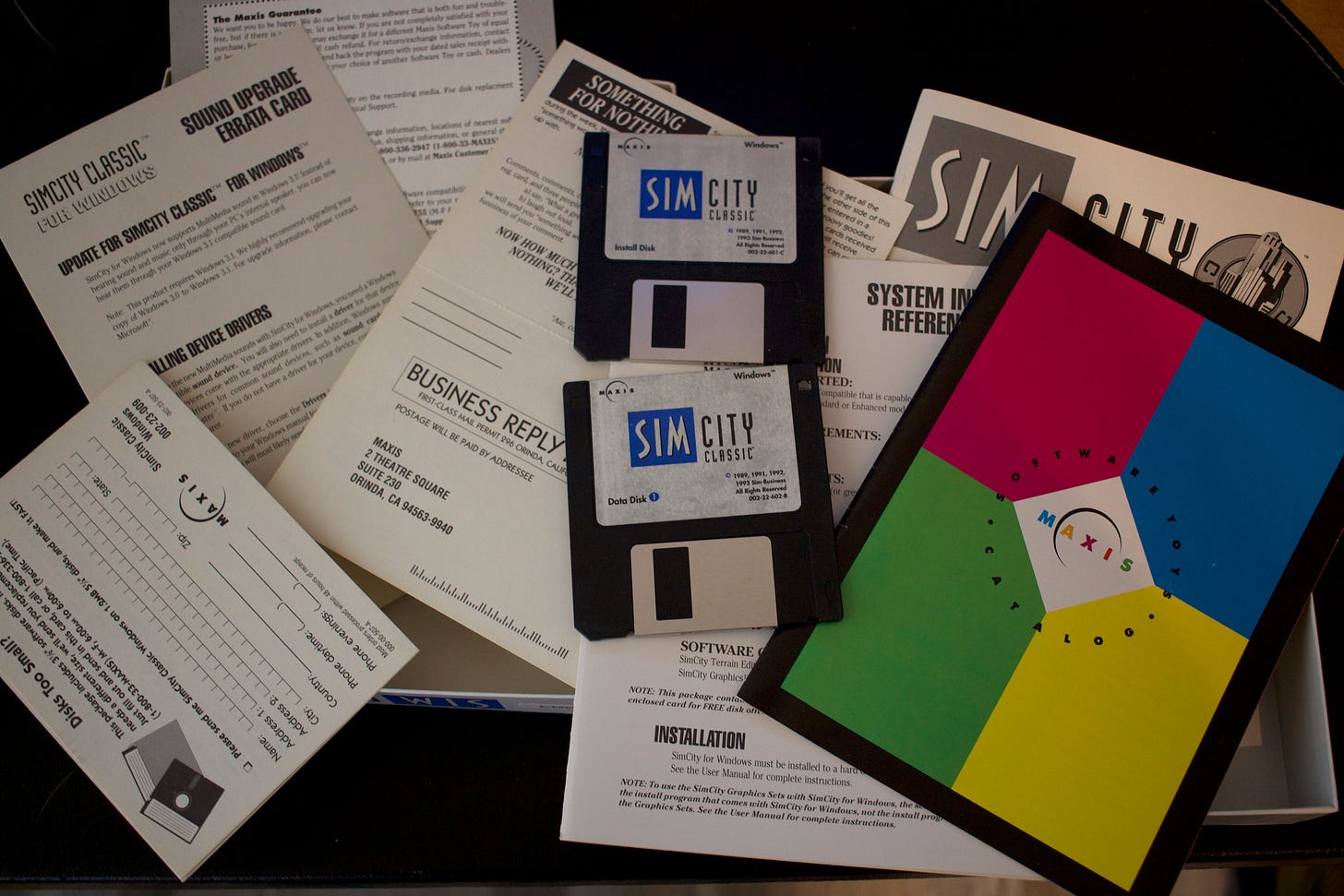SimCity
the city simulator
As a child, I was blessed with an abundance of computing machinery with which I could while away rainy days. One of the games that seemed capable of consuming day after day was SimCity. Rain, storms, tornadoes, snow, and ice were all common where I grew up. This wasn’t just a casual rain, but rather more like buckets of water falling upon you for days in a row. Sometimes, I’d brave whatever the weather was just to get outside, but more often… the sweet sounds of the PC starting up, and then the glorious Adlib sounds of SimCity. A tall glass of chocolate milk, maybe a few cookies, and the whole day would disappear in an electronic world that was mine to create. To the mind of a child, SimCity was magical. I could create any metropolis and imagine myself living there, and I could then live through a movie with tornados, fires, and monsters! A computer running SimCity coupled a child’s mind was a near limitless wonderland that had a side-effect of teaching basic planning and budgeting skills.
For me, the only downside was that the MS-DOS machine was the family computer. In my bedroom, I had an Atari 800XL. SimCity was released for the ST but not the 800XL, and therefore if my parents had to use the computer for some legitimate purpose, I was out of luck. As such waiting… perhaps impatiently… was a common feature of SimCity for me. Never fear! My near addict-like behavior regarding SimCity was fueled by planning city changes and expansions on notebook paper; drawing out the zoning squares, the streets, the train, and so on in pencil.
When my parents finally upgraded from the XT to a generic 486 clone machine, the XT became my computer. This was a mixed blessing. On the one hand, I now had unlimited access to SimCity (among other games), but I also now understood that the XT was slow. It wasn’t just mildly slow, but truly terribly bad. Even after having been upgraded to the NEC V20, and after having gotten a memory expansion board, the thing was slow and old. I was grateful to my parents (truly), but I also still wanted time on the better machine, and this meant shuttling floppies back and forth between the two computers. Luckily, I no longer had to keep hand drawn maps of my cities for offline planning (except for when I was at school).
Naturally, I played the MS-DOS version for quite sometime. I had the XT, and it was easy enough to install the game on the 486 as well. Like many enterprising nerds at the time, I had a lawn mower, a rake, a snow shovel, and I was more than willing to spend some of my youthful energy to get some money to buy more games. This meant I could get the Windows version!
Armed with the Windows and MS-DOS versions of the game, and my floppies to carry my game saves, I thought I was enjoying the best there was! Then, my friend down the street got the game on his SNES. His version was slightly different. There was this animated advisor guy, some of the animations were different, and obviously using a controller was a bit difficult for me at first. I remember quite a few nights of us hanging out with one of us on his computer, and one of us on his SNES. We would have “races” where we’d try to out build the other in a given amount of time. Typically, whoever was on the PC would win, but occasionally one would get hit with disasters on the PC and the other would race ahead on the SNES.
SimCity was described as a software toy by its creators at Maxis. I believe this is a rather apt turn of phrase. SimCity isn’t a game in the traditional sense as there is no predetermined end-goal, there is no story arch, and there is no end. SimCity can be played indefinitely. It allows for creativity within the bounds of the simulation. In this sense, SimCity (and contemporary titles like Civilization) were among the first digital sandboxes.
Today, you can play SimCity in your browser via micropolisJS or via the Internet Archive. Many Linux distributions also have packages of Micropolis.
SimCity is a software toy whose influence over the modern gaming landscape is quite immense. Countless updates, spinoffs, clones, and recreations exist. The game was ported to pretty much everything: the ZX Spectrum, the Amstrad CPC, the NES, the SNES, the C64, the Macintosh, the Amiga, the Atari ST, the Acorn Electron and the Archimedes, PalmOS, UNIX, MS-DOS, Windows, OS/2, Symbian, and JS. I am proud to own a few copies of the game, and I still enjoy playing it, but perhaps not for days at a time anymore.










Your articles are great! I love reading them. I have the same good memories. Go on! :-)